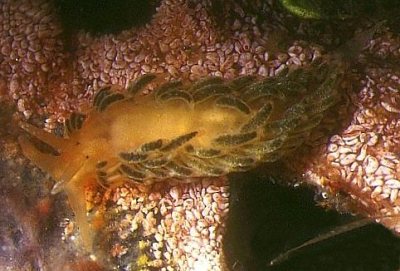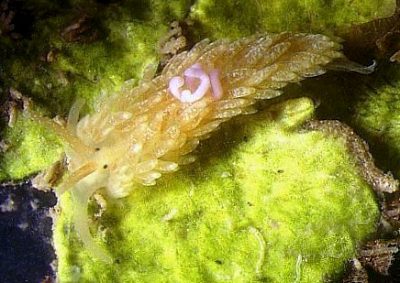Aeolidiella alderi or A. glauca
January 21, 2003
From: Mauro Doneddu


Dear Bill,
Looking for photos of colour variety of Aeolidiella alderi from Mediterranean, I re-examined all my old photos, and noted some atypical patterned specimens. They have the big eyes and the cerata pigmentation of Aeolidiella glauca, and I am doubtful between the two species. Here are enclosed 2 photos of different specimens that I sent some years ago to the Koehler's "Mediterranean Slug Site" as Aeolidiella alderi. What is your opinion?
Upper Photo:
Size: 15mm
Depth: 3m
Date: September 1993
Country: Italy, Sardinia Island
Village: Porto Istana
Divesite: Porto Legnaiuolo
Lower Photo: with parasite
Size: 18mm
Depth: 2m
Date: September 1993
Country: Italy, Sardinia Island
Village: Porto Istana
Divesite: Porto Legnaiuolo
Mauro.
maurodo@tiscali.it
Doneddu, M., 2003 (Jan 21) Aeolidiella alderi or A. glauca. [Message in] Sea Slug Forum. Australian Museum, Sydney. Available from http://www.seaslugforum.net/find/8923Dear Mauro,
I guess I should wait and let an expert from Europe comment on your photos, because as Bernard Picton says in an earlier message these species are quite tricky to distinguish externally. It seems however that A. alderi can be distinguished by an interesting feature of its most anterior cerata. Most aeolids have a cnidosac at the tip of their cerata in which they store stinging cells [nematocysts] from their cnidarian prey. A. alderi, which feeds exclusively on sea anemones, has very large cnidosacs in its most anterior cerata, for the storage of special long nematocysts, apparently useful when attacking sea anemones. Because the upper half of the anterior cerata are filled with these large cnidosacs, their dark digestive gland duct is much shorter than in the rest of the cerata, and appears as a white 'ruff' or band across the first ceratal clump on each side. You can see that clearly in Alma Sánchez's photos.
If you look carefully in both your photos, you will see that the upper half of the cerata in the first row is white, or at least lacks the darker digestive gland. From that I would suggest your animals are A. alderi. Your lower photo look very similar to Jean-Pierre Bielecki's, even down to having the same copepod parasite, as can be seen by the sausage-shaped purple egg sacs.
Best wishes,
Bill Rudman
Related messages
-
Aeolidiella alderi from Thau, French Mediterranean
From: Dominique Horst, November 28, 2007 -
Aeolidiella alderi from Croatia
From: Mat Vestjens, July 13, 2006 -
Aeolidiella alderi from Bembridge, UK
From: Rebecca Cooksley, September 29, 2005 -
Aeolidiella alderi from UK
From: Judith Oakley, August 8, 2005 -
Aeolidiella alderi from sthn England
From: Judith Oakley, May 13, 2005 -
Guernsey opisthobranch
From: Richard Lord, November 20, 2003 -
Aeolidiella alderi - defensive behaviour
From: Marina Poddubetskaia, August 25, 2003 -
Aeolidiella alderi + eggs
From: Marina Poddubetskaia, August 10, 2003 -
Aeolidiella alderi from Tunisia
From: Anis, April 22, 2003 -
Aeolidiella alderi from Strait of Gibraltar
From: Alma Sánchez, January 29, 2002 -
Re: Cuthona granosa ? from the Mediterranean
From: Bernard Picton , January 9, 2002 -
Cuthona granosa ? from the Mediterranean
From: Jean-Pierre Bielecki, December 19, 2001 -
Aeolidiella alderi
From: Jean-Pierre Bielecki, March 17, 2001 -
Aeolidiella alderi and parasite
From: Jean-Pierre Bielecki, February 20, 2001 -
Aeolidiella alderi or A. glauca
From: Bernard Picton , February 20, 2001
